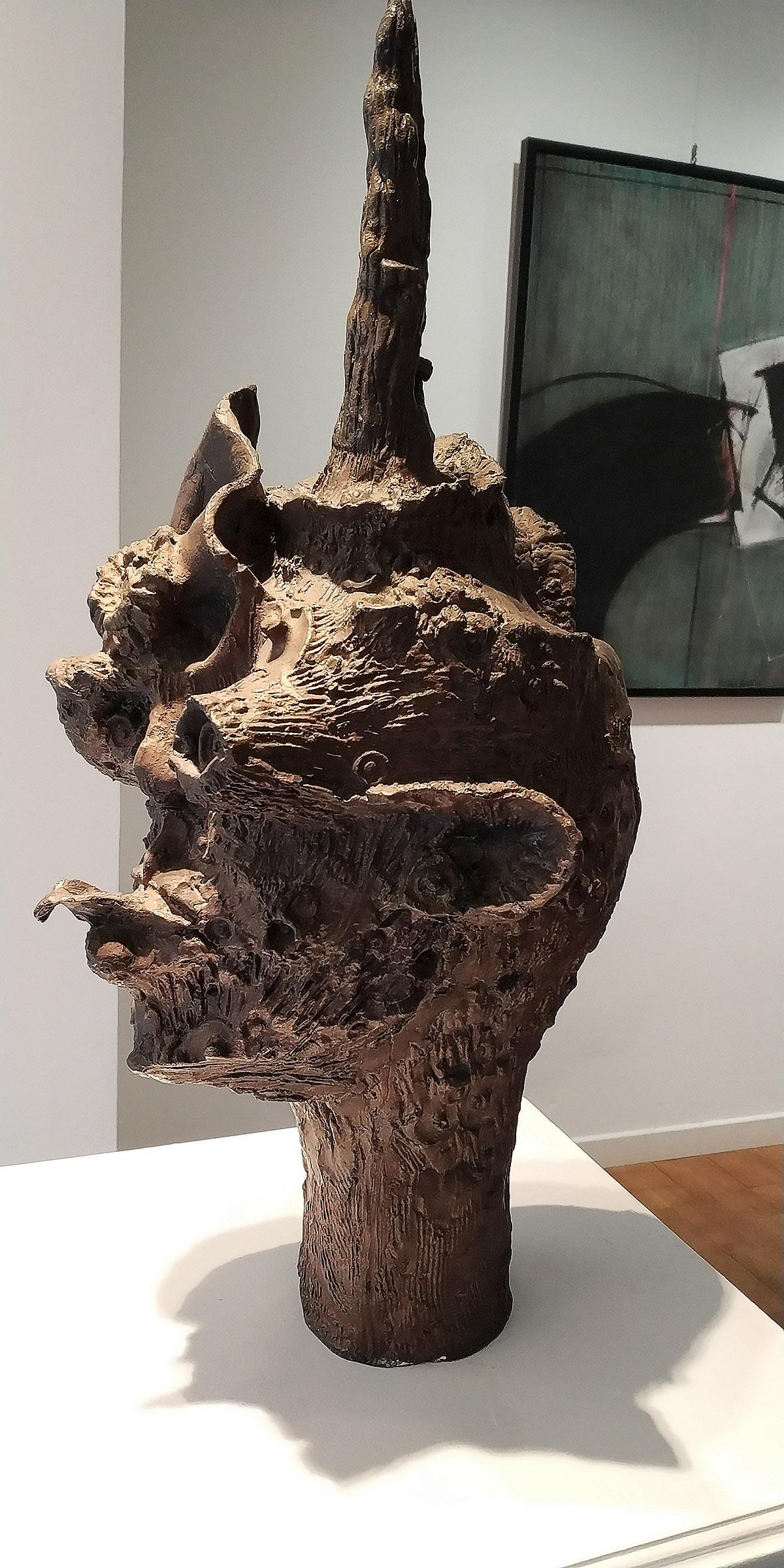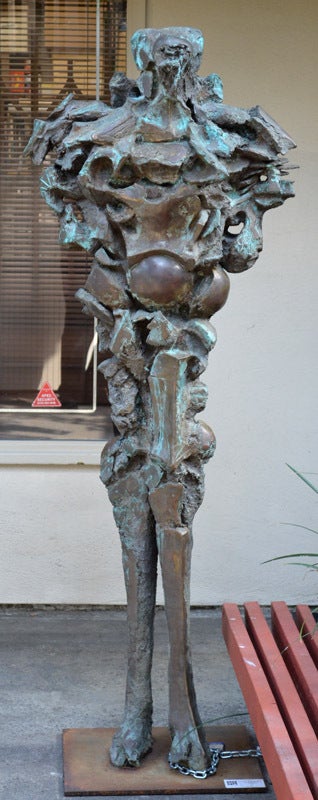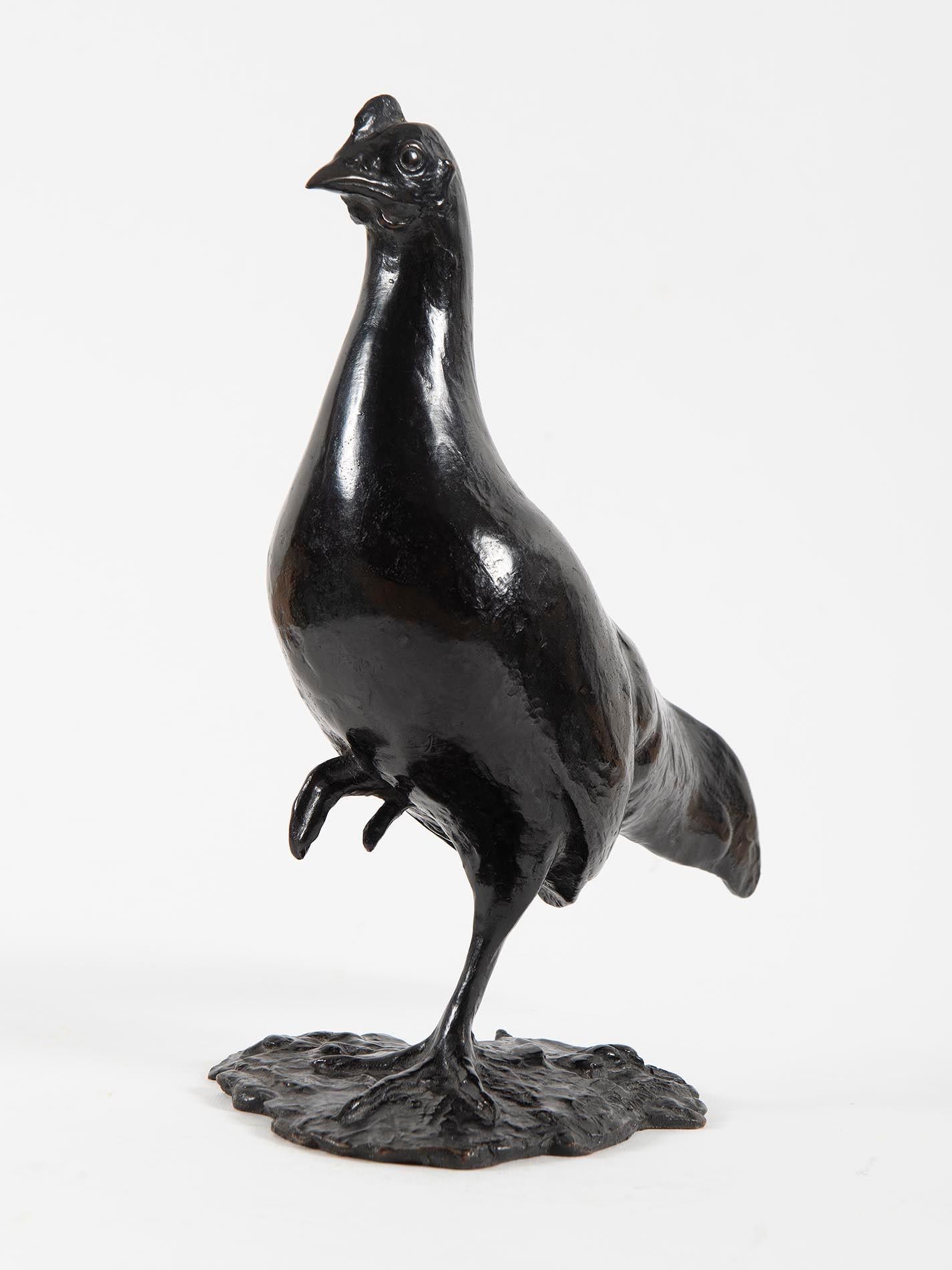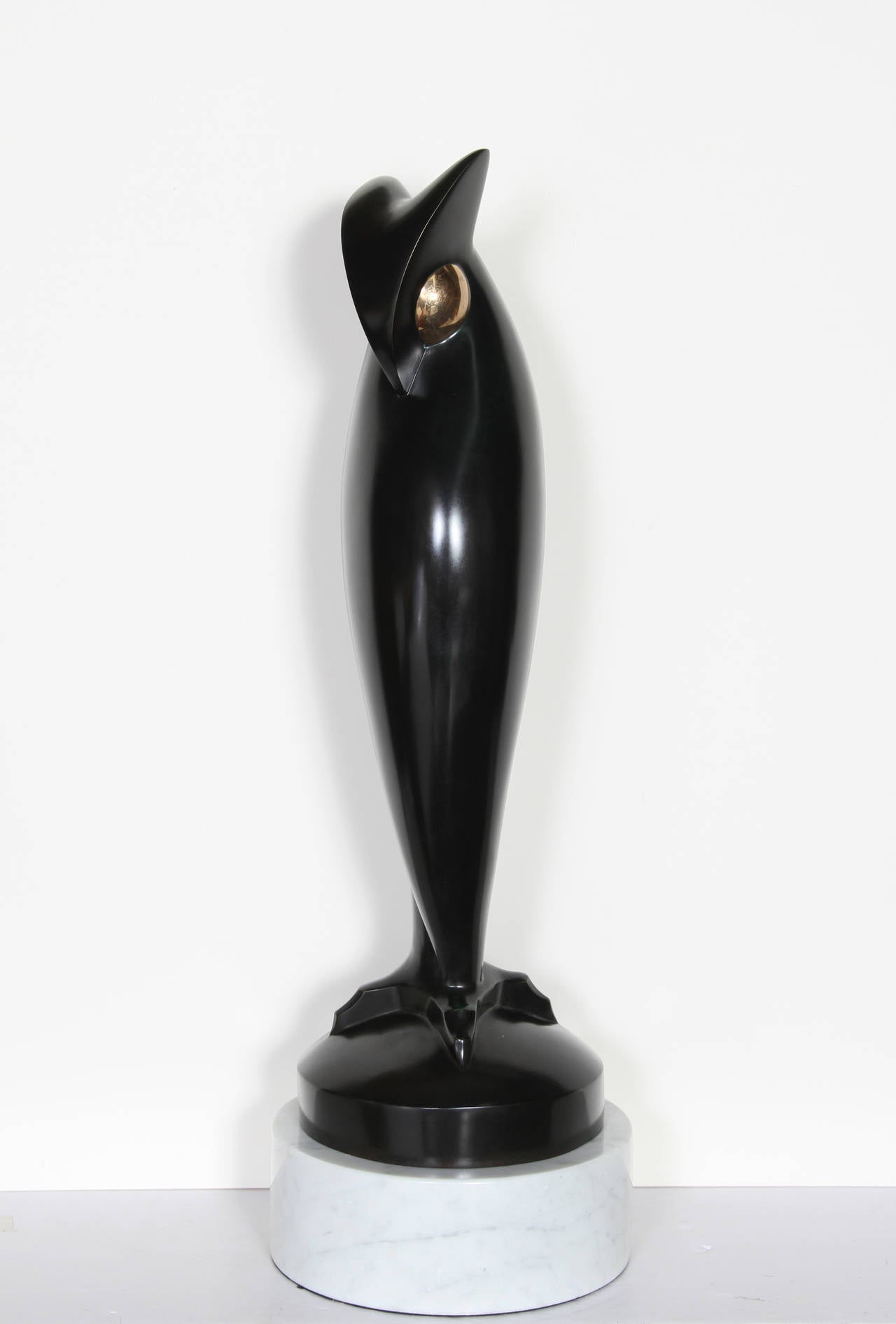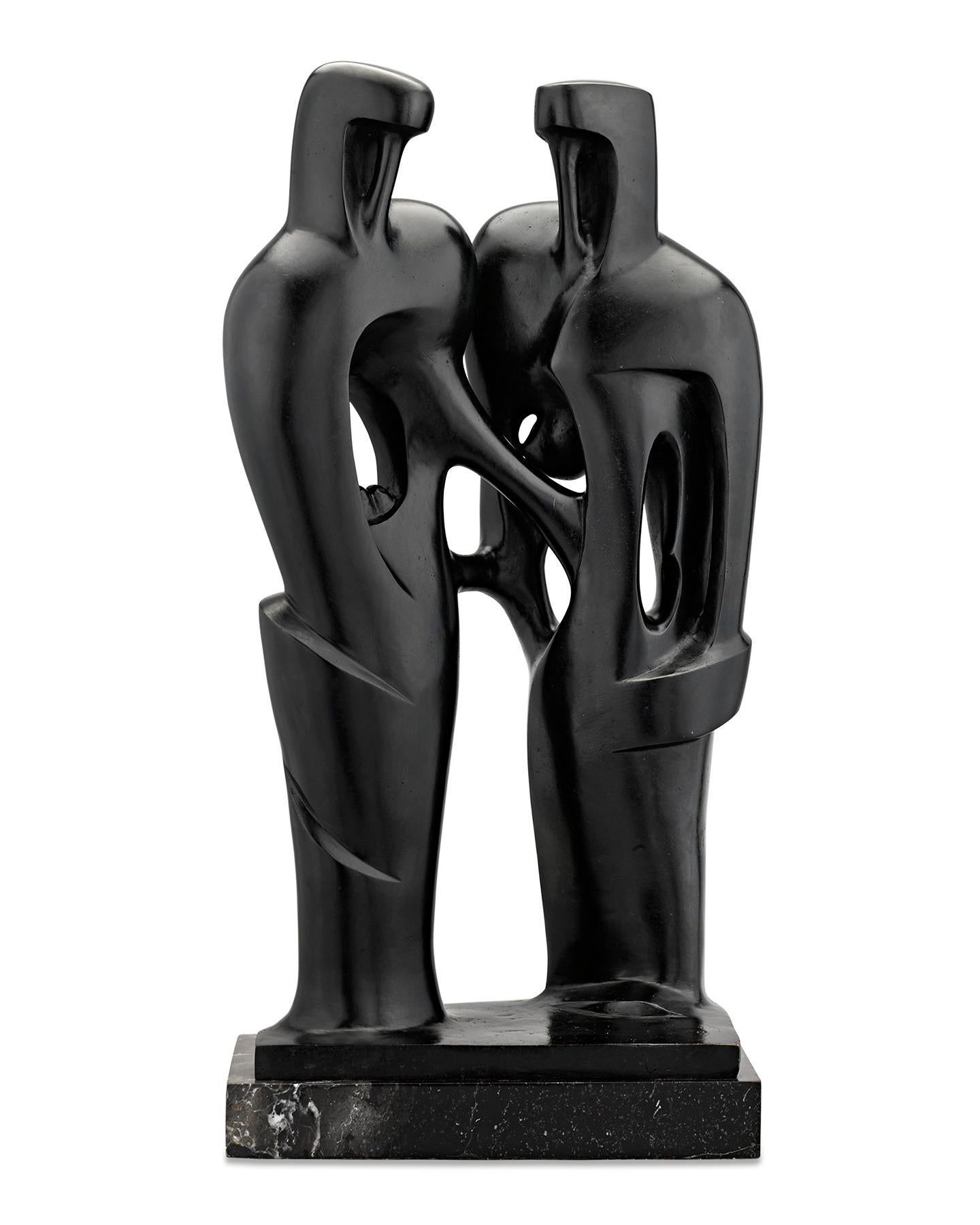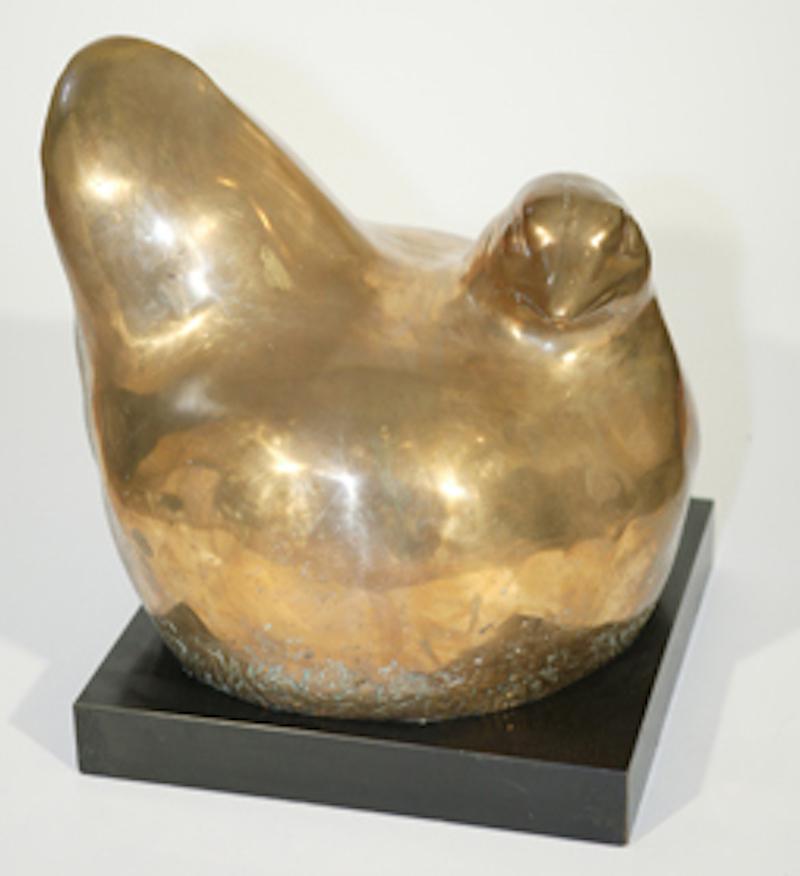Items Similar to Tête de cariatide Head of Caryatid
Want more images or videos?
Request additional images or videos from the seller
Amedeo ModiglianiTête de cariatide Head of CaryatidConceived in 1910
Conceived in 1910
About the Item
Amedeo Modigliani
1884-1920 Italian
Tête de cariatide
Head of Caryatid
Signed “Modigliani” and numbered “1/8” (near base)
Bronze
The figural works of the iconic modernist Amedeo Modigliani are known for their instantly recognizable style, and they are among the most coveted in the world of art collecting, with Modigliani ranking among the world’s ten most valuable artists of all time. This monumental bronze, conceived by the artist in 1910, demonstrates his mastery of sculpture. Sculpting was the artist’s self-proclaimed first and true passion — a fact sometimes overlooked due to the success of his paintings and the overwhelming rarity of his sculptures. His famed Tête series from which this bronze hails stands as his most important sculptural output, with works recognized for their timeless quality and strong, stoic presence. Tête de cariatide reflects these qualities and provides a compelling glimpse into Modigliani’s greatest artistic passion.
This bronze is an enlarged casting of a wooden sculpture — the only known sculpture that Modigliani carved in wood rather than stone. Commissioned posthumously by Modigliani’s daughter Jeanne alongside the Modigliani Institute, the bronze iteration here perfectly captures the rich woodgrain texture of Modigliani’s original carving and retains its careful compositional balance. Soulful and intense, it reflects the exaggerated yet elegant elongation of the artist’s figural paintings, which became his much sought-after signature style.
Modigliani’s interest in African and other non-Western art is well-documented. This bronze is reminiscent of a tribal mask or ancient deity, both due to its exaggerated features and the totemic appearance achieved by the work’s texture, meditative presence and sheer size. Yet the work also alludes to the artist’s Italian heritage and training. A caryatid is a staple of classical architecture, an ornate column typically found on the façade of a temple that takes the form of a female figure, with the most famous examples being on the Acropolis of Athens. The present sculpture exudes the same striking, memorable quality.
Born in Livorno, Italy in 1884, Modigliani dreamed of becoming a sculptor from a young age when he first encountered the grand marbles of Michelangelo. He moved to Paris in 1906, but it was not until 1909 after meeting modernist sculptor Constantin Brancusi that he began carving figures. For a time, he devoted himself almost entirely to sculpting, completing very few paintings between 1911 and 1914 but producing several sketches and gouaches relating to his sculptural projects. Modigliani exhibited a series of his sculptures in the 1912 Salon d'Automne.
Among the reasons Modigliani’s work is so highly sought after is the fact that the artist died at the premature age of 35, limiting his entire lifetime production to under 400 total artworks. Within that number, his sculptures are exceedingly rare; he only created around twenty-six total, most of which are held in museums such as the Museum of Modern Art (New York), the Metropolitan Museum of Art (New York) and the Tate Gallery (London). Modigliani suffered from tubercular meningitis his entire life, which ultimately limited his ability to continue to pursue the physical and laborious art of sculpting, emphasizing this bronze’s importance and rarity with the artist's oeuvre.
The other editions of this series can be found in public collections worldwide, including Morocco, Saudi Arabia and the exterior of the Casa Natale Modigliani in Rome, which houses the Modigliani Institut archives.
Conceived in 1910. Posthumous, contemporary casting circa 2006.
Bears the foundry mark of Paolo Olmeda as well as the artist’s signature and edition number “1/8”
24" wide x 34" deep x 90" high
Base: 35 3/4" wide x 45 3/4" deep x 28" high
- Creator:Amedeo Modigliani (1884 - 1920, Italian)
- Creation Year:Conceived in 1910
- Dimensions:Height: 90 in (228.6 cm)Width: 24 in (60.96 cm)Depth: 34 in (86.36 cm)
- Medium:
- Movement & Style:
- Period:
- Condition:
- Gallery Location:New Orleans, LA
- Reference Number:
About the Seller
5.0
Vetted Seller
These experienced sellers undergo a comprehensive evaluation by our team of in-house experts.
Established in 1912
1stDibs seller since 2013
14 sales on 1stDibs
Typical response time: 6 hours
- ShippingRetrieving quote...Ships From: New Orleans, LA
- Return PolicyThis item cannot be returned.
More From This SellerView All
- CoupleBy Agustín CárdenasLocated in New Orleans, LAInfused with a crisp modernity and subtle sensuality, this bronze sculpture by Cuban-born artist Agustin Cárdenas is an exceptional example of late-2...Category
20th Century Modern Figurative Sculptures
MaterialsMarble, Bronze
- Sir Winston Churchill Memorial By Ivor Roberts-JonesBy Ivor Roberts-JonesLocated in New Orleans, LAIvor Roberts-Jones 1916-1996 | British Sir Winston Churchill Memorial Bronze This exceptional and iconic sculpture of Sir Winston Churchill is the original maquette for the renown...Category
20th Century Academic Figurative Sculptures
MaterialsBronze
- Girardon’s Equestrian Portrait of Louis XIVLocated in New Orleans, LAKing Louis XIV, one of France's greatest monarchs, sits confidently astride a prancing steed in this bronze equestrian statue. The extraordinary work is a reduction of the portrait of the Sun King by François Girardon, one of the most noted and influential sculptors of the period. Looking back to the great masterpieces of antiquity, Girardon took his inspiration from the seminal ancient Roman marble of Marcus Aurelius, now in the Musei Capitoline (Rome). Louis XIV is thus portrayed here as a conquering Roman hero, his costume adorned with many neoclassical motifs, hand outstretched in a gesture of command. The result is an imposing royal portrait of power and absolute authority that pays homage to one of the most important sovereigns in French history. It was in 1685, at the very height of his rule, when Louis XIV commissioned the monumental bronze of himself from the great Girardon. As sculptor to the king, Girardon was a key figure in the decoration of the gardens at the Château de Versailles, and he was later commissioned to complete several important royal...Category
19th Century Other Art Style Figurative Sculptures
MaterialsBronze
- Bronze of Pluto Abducting Proserpine after François GirardonLocated in New Orleans, LAAfter François Girardon 1628-1715 French Pluto Abducting Proserpine Bronze This High Baroque period composition captures the famed narrative of Pluto and Proserpine from Roman mythology. The late 17th-century patinated bronze, created after François Girardon's marble composition, captures the very moment that Pluto seizes Proserpine. The anguished goddess reaches skyward, attempting to escape the god’s grasp while Pluto’s stoic face betrays his knowledge that his ploy will succeed. This pivotal moment in the mythological tale has captured the imagination of many art historical greats, from Bernini to Rubens. François Girardon’s version of the climax demonstrates incredible finesse and artistry, modeled expertly in bronze in the present work by a later sculptor. The statue brings a twist of intertwined bodies into a dynamic frenzy, paralleling the tension of the legendary story. In ancient Roman mythology, Proserpine, the beautiful daughter of Ceres — known as Persephone in Greek mythology — was picking flowers in the fields when she was suddenly abducted by Pluto, the god of the underworld, and taken to his kingdom. Consumed with grief, her mother Ceres, the goddess of agriculture, scorches the earth, stopping the growth of grain and fruit. Jupiter attempts to intervene and secure Proserpine’s return to earth, negotiating a compromise with Pluto and the Fates that allows Proserpine to be released for part of the year before returning to Pluto’s underworld. Proserpine’s journey back and forth is an allegory for the changing seasons; when Prosperine is with her mother, the earth warms and provides bountiful harvests. Upon her annual return to the underworld, however, the earth once again becomes cold and barren. After returning to France after years of training in Rome, François Girardon quickly rose to become one of the greatest artists in France. He was elected a member of the Académie Royale de Peinture et de Sculpture in 1657 and would become Chancellor of the Royal Academy in 1695. The artist was approached frequently for royal commissions and Girardon’s Pluto was originally commissioned by Louis XIV for the gardens at his Palace of Versailles. It was one of four monumental marble groups intended to decorate the corners of Charles Le Brun’s never completed garden at the chateau, the Parterre d’Eau. Each group of three figures symbolized one of the four elements: earth, air, fire and water. Pluto’s association with hell made him the apt...Category
Early 18th Century Baroque Figurative Sculptures
MaterialsBronze
- Married Love by Oscar NemonLocated in New Orleans, LAOscar Nemon 1906 - 1985 Croatian Married Love Signed “Nemon” (on reverse) Bronze resin with green patina This rousing and sentimental sculpture, commis...Category
20th Century Figurative Sculptures
MaterialsBronze
- Vénus De Milo Aux Tiroirs By Salvador DalíBy Salvador DalíLocated in New Orleans, LASalvador Dalí 1904-1989 Spanish Vénus de Milo aux tiroirs (Venus de Milo with drawers) Signed "Salvador Dalí EA III/IV" (on base) Bronze One of th...Category
20th Century Post-Impressionist Nude Sculptures
MaterialsBronze
You May Also Like
- Unicorn - bronze sculpture - Salvador Aulestia (1915-1994)Located in Milano, MI"TERAPHIM" Salvador Aulestia's Teraphim exhibition and simultaneous video presentation of the Teraphim exhibition held in front of Leonardo da Vinci's "Last Supper" on Corso Magenta...Category
1970s Modern Figurative Sculptures
MaterialsBronze
- Walking ManBy Maxine Kim Stussy 1Located in West Hollywood, CAMaxine Kim Stussy, a prolific sculptor and painter from the late 1940’s to present. Maxine led an incredibly artistic life traveling the world with h...Category
1970s Modern Figurative Sculptures
MaterialsBronze
- Poule Cayenne, by François Pompon, 1900's, sculpture, animal, bronze, chickenBy François PomponLocated in Geneva, CHPoule cayenne - Poule faisanne, 1st proof, 1906 Bronze with a black patina 28 x 22 13 cm Signed on the base : POMPON. Seal of the founder Cire Perdue A.A. Hebrard. Numbered (M) Certi...Category
Early 1900s Modern Figurative Sculptures
MaterialsBronze
- Sleeping Owl, Bronze Sculpture by Antonovici - Brancusi's ProtegeBy Constantin AntonoviciLocated in Long Island City, NYArtist: Constantin Antonovici, Romanian (1911 - 2002) Title: Sleeping Owl Year: 1947 Medium: Bronze with Patina on Marble Base, signature and number inscribed Edition: 1/9 Size: 29 i...Category
1940s Modern Figurative Sculptures
MaterialsMarble, Bronze
- Hen, Gilded Hen in Polished BronzeBy William ZorachLocated in Brookville, NYThis Sculpture "Hen" by William Zorach in polished bronze is numbered 3/6 although according to the artist son, only 4 were ever cast. Executed in 1946, signed on the reverse and nu...Category
1940s American Modern Figurative Sculptures
MaterialsBronze
- Monument in Honor of Dead, Bronze Sculpture by NeizvestnyBy Ernst NeizvestnyLocated in Long Island City, NYArtist: Ernst Neizvestny, Russian (1926 - ) Title: Monument in Honor of Dead Year: 1970-1974 Medium: Bronze Sculpture on Wooden Base Edition: 7 + AP's Size: 16 x 10 x 6.5 in. (40...Category
1970s Modern Figurative Sculptures
MaterialsBronze
Recently Viewed
View AllMore Ways To Browse
Bronze African Tribal Head
Jeanne Modigliani
Moroccan Tete A Tete
Caryatid Column
Miguel Guia Calm And Silence
Volodymyr Kochmar
Running Cheetah
Dali Atomic
Running Cheetah Sculpture
Mexican Clay Nativity
Nathan Rapoport
Niso Maman
Ramie 307
Miguel Guia Paintings
Sahara Novotny
Vincent Magni
Balloon Miguel
Miguel Guia Street
